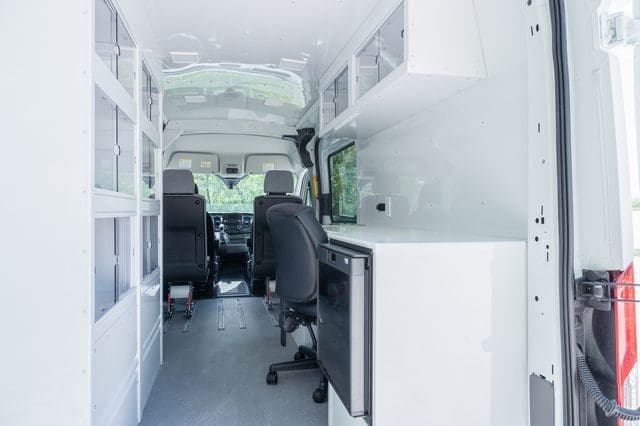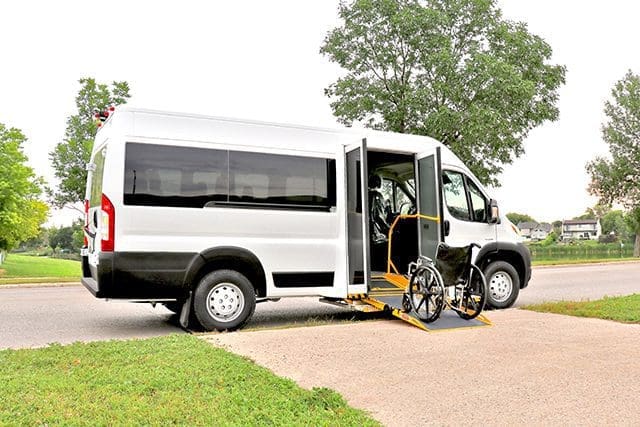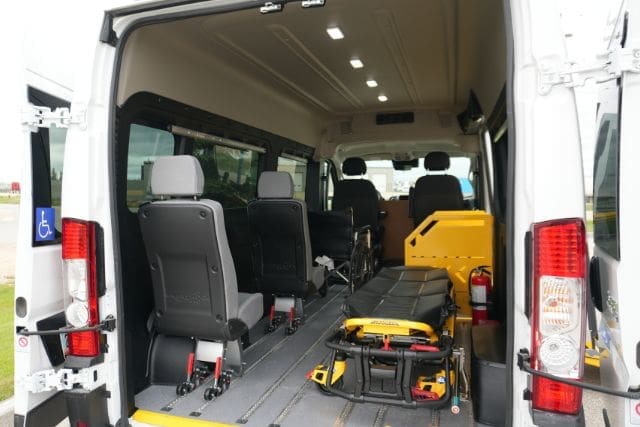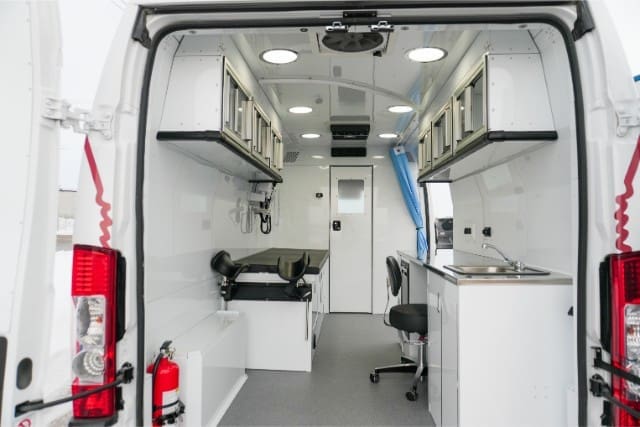Is your organization starting an outreach program, and you’re unsure which mobile medical van to choose? The wrong van can cause compatibility issues with your outreach program, accessibility issues for your clients, and even safety concerns that can jeopardize passenger well-being.
Hundreds of our clients have benefited from our mobile medical vans and wheelchair vans for their outreach programs over the years we’ve been in business. At MoveMobility, we know how frustrating it is to choose the wrong wheelchair van for your organization. That’s why we’re compiling an article like this; so you won’t end up running into issues that will slow down the success of your outreach program.
In this article, we’ll explain what an outreach program is, how your outreach program can help, and how you can choose the best Van for your organization.
What is an outreach program?
An outreach program is a way for organizations to connect with and help people in need. Try to think of it like a helping hand that goes out to find and assist people who may need support or services.
Outreach programs come in all shapes and sizes. One outreach program will offer medical assistance to sick children in remote communities, while another will be more focused on offering transportation services to the homeless communities.
Goals of outreach programs: The main goal of outreach programs is to break down barriers that prevent people from getting the help they need.
Barriers include:
- Physical barriers: People with disabilities have trouble getting around. Without accessible transportation, This can make it hard for them to get to their doctor’s appointments or other places they need to go.
- Communication barriers: People with disabilities may have trouble talking to their doctors or understanding what they’re saying. This can be caused by things like hearing, speech, or vision problems.
- Attitudinal barriers: People with disabilities are treated unfairly by others because of their disability. This can make them feel left out or like they don’t belong.
- Financial barriers: Disabled people have trouble paying for healthcare. This is caused by not having insurance or having to pay more out-of-pocket money than they have. This can make it hard for them to get the care they need.
- Geographic barriers: People with disabilities who live in rural areas have trouble getting to their doctor’s appointments. There aren’t many transportation options in remote areas.
How can your outreach program help?
Your outreach program can help address all of the above barriers and more:
Accessibility: Wheelchair vans are made to accommodate wheelchairs. This makes it easier for your clients with mobility issues to access the vehicle.
Convenience: Wheelchair vans are comfortable and safe for people traveling in them. This reduces the stress of travel for disabled people.
Appointments: Your organization can help people go to their appointments without hassle.
Community access: Wheelchair vans bridge the gap for those living in remote areas by providing a means to reach essential services.
Mobile Outreach Vans

If the goal of your mobile outreach program stretches beyond just transporting individuals, you’ll need an innovative solution. At MoveMobility, we manufacture four types of mobile medical vans. Our dedicated Mobile Outreach Van (MO Model) is used by programs that provide outreach services like:
- Overdose prevention
- Harm reduction
- Mobile health
- Housing support
- Mental health counseling
- Addictions counseling
- Referral services
The MO Model is a versatile choice for many types of outreach programs and you can expect to pay between $150,000 to $230,000 for a Mobile Outreach Van.
It has useful features, like tall storage cabinets, a desk area, and options for a sink and fridge. You also get overhead storage, removable seats, and a reliable power source, making sure you have the space and resources you need to help your clients. The van even has rear heating and air conditioning to keep individuals comfortable.
Different layouts can fit various needs. Whether you’re transporting staff or clients or providing on-site services, this van can handle it all. All the surfaces are easy to clean and suitable for medical use. It has strong aluminum cabinets that slide open and an office space for extra convenience.
The van is set up with features like a secure rolling chair, desk space, storage for equipment and records, overhead lights, cabinets, and a reliable power source. You can also choose to include extras like a sink, fridge, extra power, or a divider.
In areas of Canada that face harsh weather, such as Manitoba, the van’s heating and cooling system, bright LED lights, and anti-slip steps on the running boards ensure a safe and comfortable workspace for all your outreach activities.
What features should certain outreach programs use?
The features of our Mobile Outreach Vans can be highly beneficial for a variety of outreach programs, especially those focused on healthcare, social services, and community support.
Here’s how these features can be valuable for different types of outreach programs:
| Outreach Program Type | Key Features |
| Healthcare outreach |
|
| Social services outreach |
|
| Community support and education outreach |
|
Choosing the best wheelchair van for your outreach program

Choosing the best vehicle for your outreach program all depends on what type of program you’re running.
If your outreach program is only involved in transporting your clients around, a wheelchair van will suit your needs. It’s helpful to consider a few things to make sure the wheelchair van meets the needs of your program or agency.
Here are some key factors to think about:
Cost of new or used wheelchair vans
Decide if you want a new or used wheelchair van. A new van is more reliable and has fewer service problems, while a used van will be cheaper but will likely have more service problems now and in the future.
Sometimes a strict budget will prevent you from affording a new wheelchair van. In situations like this, you have a few options. First, read through these two articles to see if you can find any grants or funding opportunities to help you get a new wheelchair van:
If you’re unable to secure funding for a new van, you might have to go with used vans. When you’re researching used vans, think about their condition. Look at maintenance records and past repair costs. After that, see if the features in the van align with what your outreach program requires.
Here are the ballpark costs of our wheelchair vans:
| Vehicle | Budget Range |
| P Series Accessible Vans | $130,000-$180,000 |
| Ram Promaster & Ford Transit Classic Series | $120,000-$155,000 |
| T Series Accessible Van | $145,000-$180,000 |
| VL Series | $110,000-$135,000 |
| Rear Entry Minivan with manual ramp conversion | $92,000-$110,000 |
Budget ranges are for informational purposes only and are subject to change without notice.
Side entry or rear entry
The next thing you need to think about when choosing the best wheelchair van for your outreach program is whether you want a side entry or rear entry van.
Choosing between a side entry and a rear entry wheelchair van depends on your specific needs and operational requirements. Let’s take a look at some considerations for each.
Side entry
Accessibility: Side entry vans offer convenient access for passengers in wheelchairs. This is especially useful when you have individuals who need assistance getting in and out of the van.
Space and seating: Side entry vans offer ample interior space with two wheelchair positions. There is a 3-person bench with a folding footrest, as well as a removable front passenger seat.
Maneuverability: Side entry vans are shorter than some of the other mobility vehicles on the market, such as buses. This makes them easier to navigate in tight spaces. This can be helpful when you operate in urban or crowded areas.
Loading and unloading: Side entry vans allow for loading and unloading without needing a lot of clearance behind the vehicle. This can be helpful when parking in confined spaces or alongside curbs. If you’re running an outreach program in a busy city, it’ll be easier to load and unload a side entry van.
Rear entry
Multiple wheelchairs: Rear entry vans are often better suited for transporting multiple individuals in wheelchairs at the same time. If your outreach program serves larger groups, this could be a deciding factor.
Simplicity of use: Rear entry vans are a little more straightforward to operate for your clients in wheelchairs. With a rear entry minivan, wheelchairs just go up the ramp and remain in their front-facing position. In side entry minivans, the wheelchair needs to be turned facing frontward after it goes up the ramp.
Flip & fold seating: Another nice thing about rear entry minivans is their flip & fold seating arrangements for 2nd-row seats. This lets you secure the wheelchair in the 2nd row behind the driver and front passenger.
Lift or ramp
Decide whether you want a wheelchair ramp or lift. Ramps allow passengers to be independent and are easy to use for wheelchairs, but require the driver to push a manual wheelchair up the ramp. Lifts require no physical effort from drivers but may block the rear or side doorway.
If you’re unsure if you want a ramp or a lift in your wheelchair van, read these three articles for more insight on that:
- Powered Ramps for Wheelchair Vans (Pros & Cons)
- Lifts for Wheelchair Vans: Pros & Cons
- Ramps vs. Lifts for Full-Size Wheelchair Vans: What You Need to Know in 2023
Minivan or full-size van
You also need to figure out how many wheelchairs your van will be taking regularly. This is important to determine what size of van you’ll need.
Look at this chart for a better idea:
| Wheelchairs | Minivan | Full-size van |
| 1 wheelchair | ✔ | ✔ |
| 1-2 wheelchairs | ✔ | ✔ |
| 1-3 wheelchairs | ✘ | ✔ |
| Passengers | ||
| Up to 4 | ✔ | ✔ |
| Up to 10 | ✘ | ✔ |
If you’re running a smaller outreach program that’s only focused on transportation of between 1 and 3 wheelchairs and up to 4 passengers, a wheelchair accessible minivan will be suitable for your needs.
If you’re transporting between 1-3 wheelchairs and up to 10 passengers, you’re better off going with a full-size wheelchair van.
What’s next for your outreach program?
You came to this article because you were looking for more information on how to choose the best vehicle for your outreach program.
You learned that wheelchair vans are ideal if your outreach program is only focused on transportation, while Mobile Outreach Vans are geared toward more specific outreach services.
At MoveMobility, we’ve manufactured hundreds of wheelchair accessible and mobile medical vans that our clients use for many purposes. With so much information out there, we know how difficult it is to choose the right vehicle for your needs.
We hope you have a better idea of which vehicle to choose for your outreach program. To continue on in the process, you’re probably thinking about what other manufacturers are charging.
Read our article on comparing wheelchair van quotes for more information on that.
Additionally, you’re probably wondering how you can pay for one of these vehicles. Read our article on your payment options with MoveMobility for a closer look at that.








